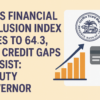Singapore’s DBS Bank is unique for using technology to make banking efficient, convenient and customer-centric. The bank’s CEO Piyush Gupta had bet big on technology. Today, the bank has the largest application programming interface platform for third-party developers of any bank in the world.
Gupta had once said in an interview: “When we first started out along this road, we compared ourselves with emerging fintechs and the startup world and concluded that we really had to digitize completely, not just by putting on digital ‘lipstick’. We made killing paper a big mantra in the organization, for instance, and were determined to go beyond just tacking on a bunch of digital apps at the front end – that’s the easy bit. We wanted to go all the way through to middleware and the back end.”
The bank has set up an enterprise-wide Centre of Excellence (COE) in Robotic Process Automation (RPA), making it the first-of-its-kind large-scale implementation in the financial services sector in Singapore and the region. Since the center has gone live, the bank has optimized more than 50 complex business processes across the bank. The RPA program is now being progressively implemented in other markets including Hong Kong, China, India, Indonesia and Taiwan. The bank believes cognitive and robotics process automation is an important capability that will help with the necessary speed and agility to meet the rapidly changing demands of customers and the evolving financial services marketplace.

Neal Cross believes it is essentially design thinking and experimentation, besides understanding of the customer,that brings in a culture of innovation in an organization
Piyush Gupta believes banks have to be like technology companies. Banks have to ’embrace’ the same technology as other technology-focused entities do and change their culture to be ‘like a startup’, he said at a recent conference. “One, we got to be able to embrace the same technology that these technology firms do. That’s not tough, because technology is freely available. Today you go to Amazon’s website and you can get everything, open source gives you everything. But you have to be willing to re-architect your fundamental technology to be like a tech firm,” says he.
There is a whole lot of transformation that is happening in the bank. One person, who is at the center of this transformation is Neal Cross, Chief Innovation Officer at the bank. He gives the perspectives of this transformation:
Babu Nair: What is the innovation culture at DBS Bank?
Neal Cross: At DBS Bank, more than 24,000 people are responsible for innovation. The culture at many banks and large corporations are following that of the tech companies. Technology is easily available but building the culture is a challenge. Having worked at Microsoft, I am well-versed with the culture of a large tech company. At DBS Bank, we to build culture of innovation, where we function like a 24,000-person start-up. Adopting this culture boosts the morale of employees, where they believe that they can achieve and innovate. We are focusing on innovation to solve customer problems. There’s a shift in the thought process – we are focusing more on what customers and that is making banking simple, frictionless and hopefully invisible.
Can you define invisible banking?
We are in a world where finance is separated from the customer journey. We need to have a world where APIs are more prevalent, and banks collaborate with merchants for more efficient banking services. That doesn’t mean key things like security, and regulation are compromised. In India, we rolled out the nation’s first branchless, paperless and signature-less bank, digibank, back in April 2016. This was made possible with Aadhaar. Bank accounts could be opened at a Cafe Coffee Day. We used a similar model in Indonesia last year.
How has the take-off been in Indonesia?
The take-off in Indonesia has been great. These past few years, we have transformed for a traditional bank to one that customer-focused. Consumer behavior is changing very quickly, and banks need to keep up with their changing payment and transaction habits.
What percentage of budget is locked for innovation?
Every single project in the bank is now treated as an innovation project, with very few exceptions. We are currently running 350 of these innovation projects. Every project we do, apart from working on core infrastructure pieces, are now specified as journeys which focus on customers or employees. The DBS workforce currently stands at around 24,000 employees, and 14,000 of them went through an innovation project or workshop in the last year. We want to inspire our employees to do their best work, be it by helping them understand the customer journey better, build prototypes, run experiments or use agile of software deliveries. We fundamentally want to change the way projects are executed.
Is there any standard process for inculcating culture of innovation?
Essentially it is design thinking and experimentation. We must understand the needs of the customer, rapidly come up with ideas to solve their problems and go back to the customer to test it. Every year DBS does over 1,000 experiments, they range from small to large-scale . For example, we wanted to know if students would like free Spotify subscriptions as part of their credit card rewards program. To test this, we created a brochure and talked to students around a university campus to get their feedback before moving ahead with building the product and releasing it. My team’s job is to educate, inspire and guide employees through their projects. People often confuse digital with technology, but we keep saying “Don’t digitize your bank, digitize your staff and they will digitize your bank”. At DBS, we are attracting talent we have never hired before, and at the same time Google and Facebook want to collaborate us.

Hack2Hire session
Apart from technology what are the other things which can make banking effortless?
APIs and an ecosystem strategy is essential for effortless banking. We launched the world’s largest bank on API platform in November 2017 and now we have 185 APIs and over 70 partners plugged into us. They range from payments, account opening, checking balance to booking a gym class using your credit card rewards points. We are adopting data analytics and artificial intelligence to understand our customers better. It is one thing to be friction-free to make banking easier, but another thing is to have contextual offers for customers. Many customers who transact digitally with us have never spoken to anyone from DBS; so the only way to offer and service them better is through their data. Analyzing their data will help us in giving better rewards on credit cards, and our customers value this.
How difficult is it to integrate technology and innovation to work like a system?
It has never been easier than what it is today. We are implementing technology which will improve the lives of our customers. We do hackathons on new technology, experiment, and build prototypes, but if it doesn’t add value to customer, then we don’t implement it.
Is it true that 40% of tech cost goes into integration of new tech?
It depends on where a company is in their technology journey. DBS is at the stage where integration of technology is at a lower cost because we have moved from outsourcing services to insourcing, and we are using technologies such as APIs and open architecture. These things have made integration much easier. In 2009, we started changing our tech infrastructure so that we could operate on a level that we are today. We don’t just digitalize for the sake of doing it, we are changing our entire architecture, investing in our people and infrastructure, and this is how we plan on achieving long term success.
What is your wish list or key things you’re looking forward to?
Regulation should catch-up with what’s happening with e-commerce giants, technology companies and what fintechs are doing. The Monetary Authority of Singapore (MAS) is doing well, RBI in India is certainly one of the leading regulators as well. It takes time to start bringing changes in regulation, but things are moving very quickly and regulators across many countries are catching up. We want to get closer to businesses. As a bank, we can go beyond lending to small businesses and get insights from them in order to play an advisory role digitally.
How close should a bank get to a customer?
In data analytics, you want to have enough information to add value to your products and services, but without the risk of making your customers uncomfortable. I think all companies are trying to work out the balance of how much data is required and to be used.







